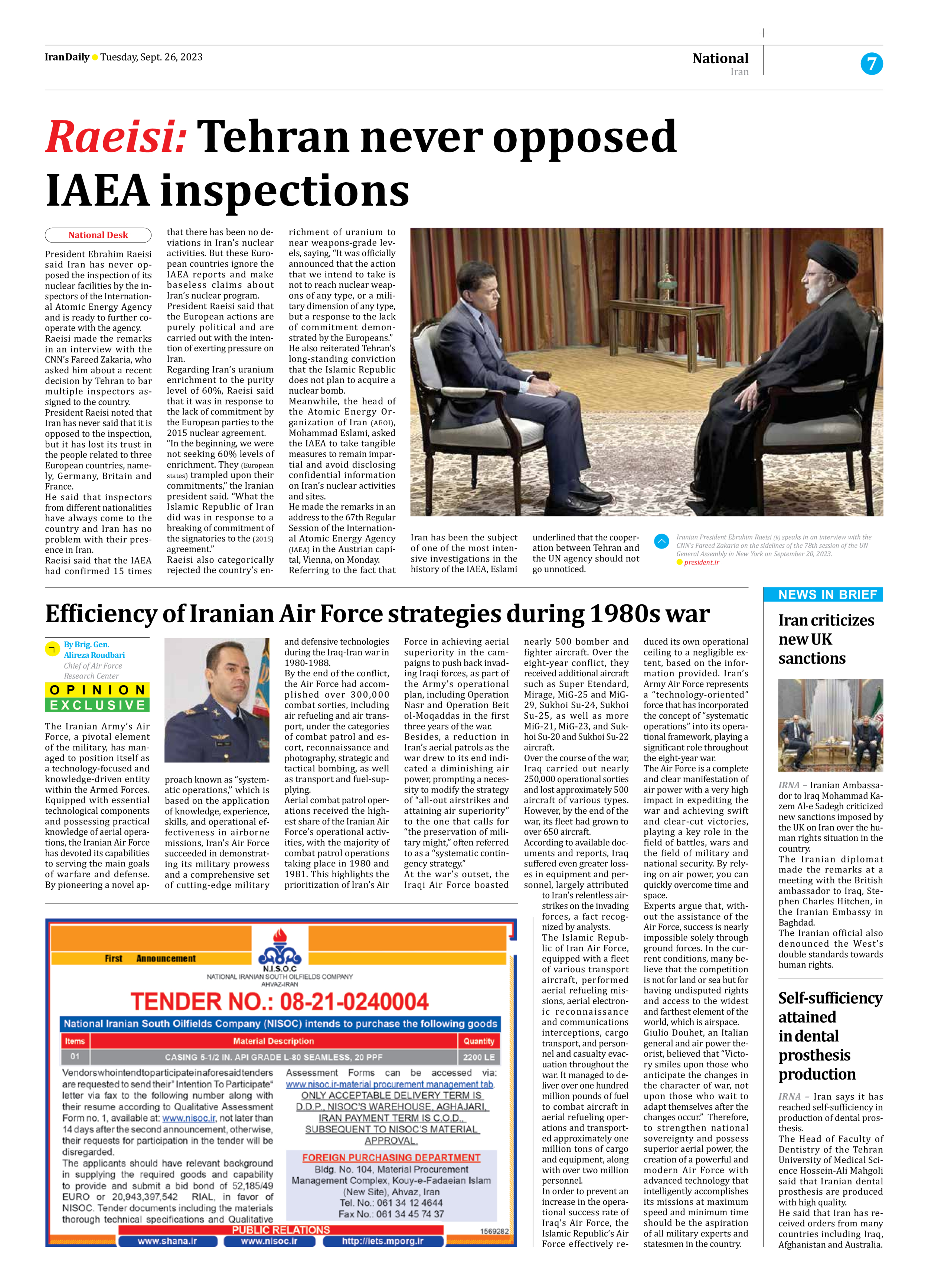
Efficiency of Iranian Air Force strategies during 1980s war
By Brig. Gen.
Alireza Roudbari
Chief of Air Force Research Center
The Iranian Army’s Air Force, a pivotal element of the military, has managed to position itself as a technology-focused and knowledge-driven entity within the Armed Forces. Equipped with essential technological components and possessing practical knowledge of aerial operations, the Iranian Air Force has devoted its capabilities to serving the main goals of warfare and defense. By pioneering a novel approach known as “systematic operations,” which is based on the application of knowledge, experience, skills, and operational effectiveness in airborne missions, Iran’s Air Force succeeded in demonstrating its military prowess and a comprehensive set of cutting-edge military and defensive technologies during the Iraq-Iran war in 1980-1988.
By the end of the conflict, the Air Force had accomplished over 300,000 combat sorties, including air refueling and air transport, under the categories of combat patrol and escort, reconnaissance and photography, strategic and tactical bombing, as well as transport and fuel-supplying.
Aerial combat patrol operations received the highest share of the Iranian Air Force’s operational activities, with the majority of combat patrol operations taking place in 1980 and 1981. This highlights the prioritization of Iran’s Air Force in achieving aerial superiority in the campaigns to push back invading Iraqi forces, as part of the Army’s operational plan, including Operation Nasr and Operation Beit ol-Moqaddas in the first three years of the war.
Besides, a reduction in Iran’s aerial patrols as the war drew to its end indicated a diminishing air power, prompting a necessity to modify the strategy of “all-out airstrikes and attaining air superiority” to the one that calls for “the preservation of military might,” often referred to as a “systematic contingency strategy.”
At the war’s outset, the Iraqi Air Force boasted nearly 500 bomber and fighter aircraft. Over the eight-year conflict, they received additional aircraft such as Super Etendard, Mirage, MiG-25 and MiG-29, Sukhoi Su-24, Sukhoi Su-25, as well as more MiG-21, MiG-23, and Sukhoi Su-20 and Sukhoi Su-22 aircraft.
Over the course of the war, Iraq carried out nearly 250,000 operational sorties and lost approximately 500 aircraft of various types. However, by the end of the war, its fleet had grown to over 650 aircraft.
According to available documents and reports, Iraq suffered even greater losses in equipment and personnel, largely attributed to Iran’s relentless airstrikes on the invading forces, a fact recognized by analysts.
The Islamic Republic of Iran Air Force, equipped with a fleet of various transport aircraft, performed aerial refueling missions, aerial electronic reconnaissance and communications interceptions, cargo transport, and personnel and casualty evacuation throughout the war. It managed to deliver over one hundred million pounds of fuel to combat aircraft in aerial refueling operations and transported approximately one million tons of cargo and equipment, along with over two million personnel.
In order to prevent an increase in the operational success rate of Iraq’s Air Force, the Islamic Republic’s Air Force effectively reduced its own operational ceiling to a negligible extent, based on the information provided. Iran’s Army Air Force represents a “technology-oriented” force that has incorporated the concept of “systematic operations” into its operational framework, playing a significant role throughout the eight-year war.
The Air Force is a complete and clear manifestation of air power with a very high impact in expediting the war and achieving swift and clear-cut victories, playing a key role in the field of battles, wars and the field of military and national security. By relying on air power, you can quickly overcome time and space.
Experts argue that, without the assistance of the Air Force, success is nearly impossible solely through ground forces. In the current conditions, many believe that the competition is not for land or sea but for having undisputed rights and access to the widest and farthest element of the world, which is airspace.
Giulio Douhet, an Italian general and air power theorist, believed that “Victory smiles upon those who anticipate the changes in the character of war, not upon those who wait to adapt themselves after the changes occur.” Therefore, to strengthen national sovereignty and possess superior aerial power, the creation of a powerful and modern Air Force with advanced technology that intelligently accomplishes its missions at maximum speed and minimum time should be the aspiration of all military experts and statesmen in the country.







